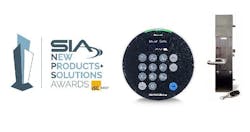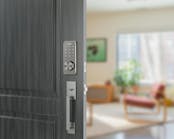20 Years Ago
Rod Oden introduced readers to a wide array of available cylinders which have high security features. Mul-T-Lock wrote an article about their Lock 500 for doors and window openings. Sargent explained the unique Keso high security line. Dale Bowman explained the protection value of Medeco padlocks. Tom Gillespie reported on continuous hinges as a profitable vertical market. Jerry Levine had tips on steel door installations. Ledger visited the Ceco Door factory. Tim O’Leary suggested the Kaba E-Plex 5000 lock system. O’Leary also introduced the Trine 4800 rim-mounted strike. Jerry Levine tested his skill att the practice installation station by Major Manufacturing. Lockmasters introduced the Softdrill, an electronic manipulation tool. Tiny serviced the locks on a 2004 Kia Amanti.
10 Years Ago
Just like this January, high security was our cover focus in January 2015. In the article “What Is High Security?” Tim O’Leary noted that the term can include the lock, the door onto which the lock is installed, the hinges and frame holding the door and even the walls adjacent to the door. Jerry Levine looked at Schlage Everest keyways. Emily Pike wrote about the Atlanta public schools working to regain key control across 27,000 doors. A Medeco case study showed how Medeco Logic eCylinders helped secure a retirement community. Steve Young’s 2015 Cloning Round-Up looked at cutting-edge programmers of the day, most of which are now obsolete. Emtek’s LISCIO Electronic Keypad Leverset with Bluetooth programming was installed on a residential door. Strike plates and latch protectors were recommended as a lower-cost security upgrade.
Fire Doors: The First Line of Defense
Ten years ago, Allegion’s Lori Greene wrote an excellent article on fire door inspections. Though codes may have evolved in the past decade, her checklists are still valid and helpful today.
The following criteria are evaluated during a fire door inspection.
- Labels are present and legible.
- No holes or breaks in door or frame.
- Glazing and glass kit / glass beads are intact and securely fastened.
- Door, frame, and hardware are in proper working order.
- No missing or broken parts.
- Door clearances are within allowable limits.
- Door closer / spring hinges are operational and door is self-closing.
- Coordinator ensures that door leaves close in proper sequence (pairs only).
- Door is self-latching in the closed position.
- Opening is not equipped with auxiliary hardware items which interfere with operation.
- No field modifications have been performed that void the label.
- Gasketing and edge seals, where required, are present, continuous, and of the proper type for a fire door.
- Signage on door covers less than 5% of door face and is not attached with mechanical fasteners.
10 Common Fire Door Code Violations
- Painted or missing fire door labels
- Poor clearance dimensions around the perimeter of the door in the closed position
- Kick-down door holders installed on the door
- Auxiliary hardware items that interfere with the intended function of the door
- Fire doors blocked to stay in the open position
- Area surrounding the fire door assembly blocked by furniture, equipment and/or boxes
- Broken, defective or missing hardware items (latch bolts and/or strike plates, closer arms, cover plates, etc)
- Fire exit hardware installed on doors that are not labeled for use with fire exit hardware
- Missing or incorrect fasteners
- Bottom flush bolts that do not project a sufficient amount into the strike
Read the full article at www.locksmithledger.com/12024038





